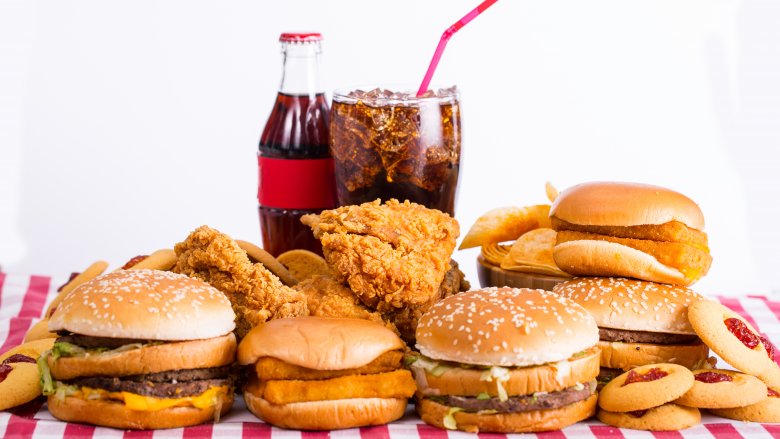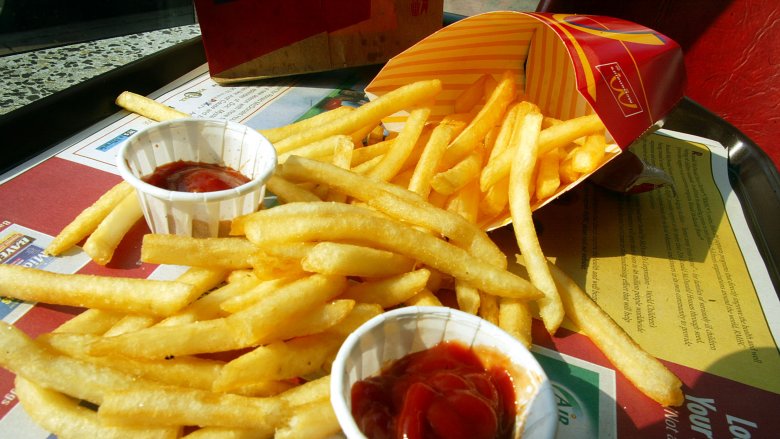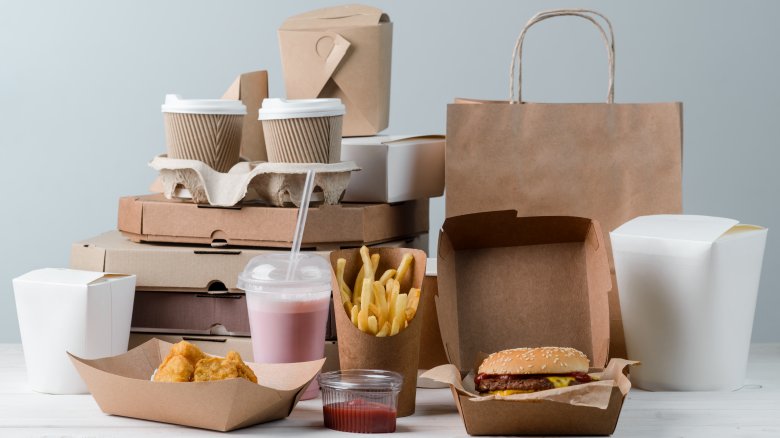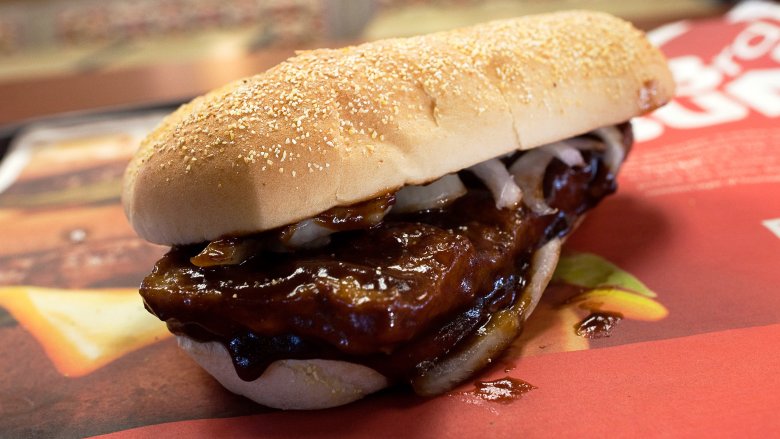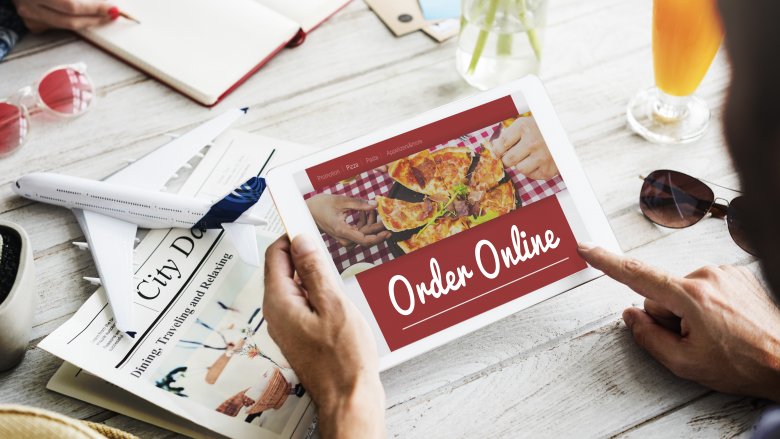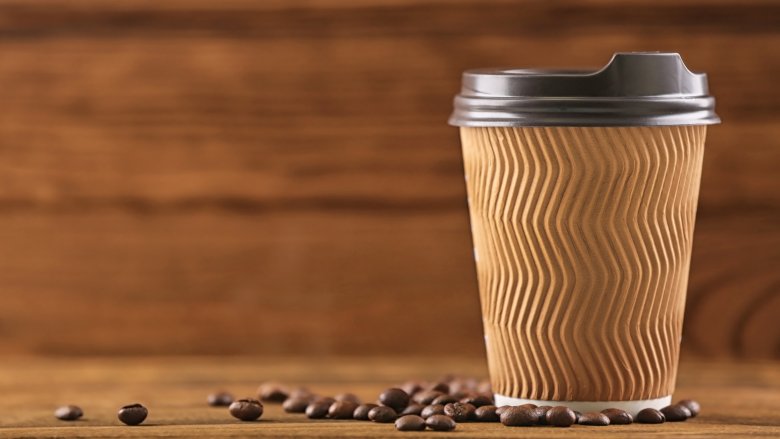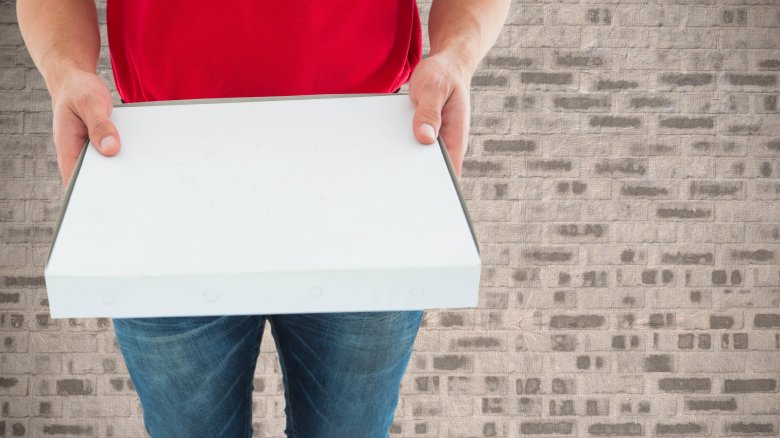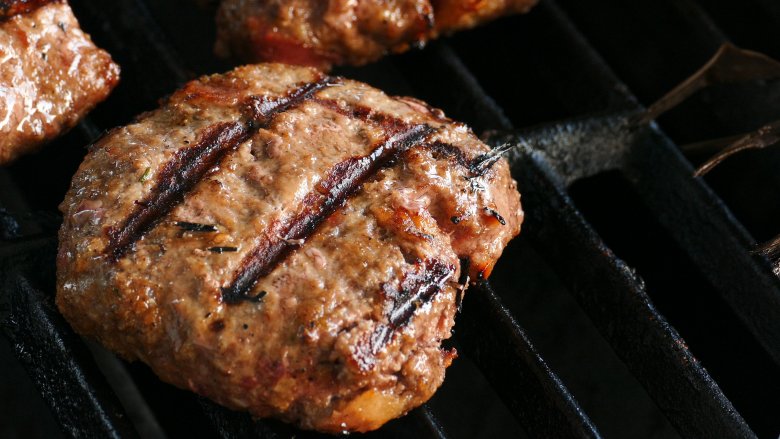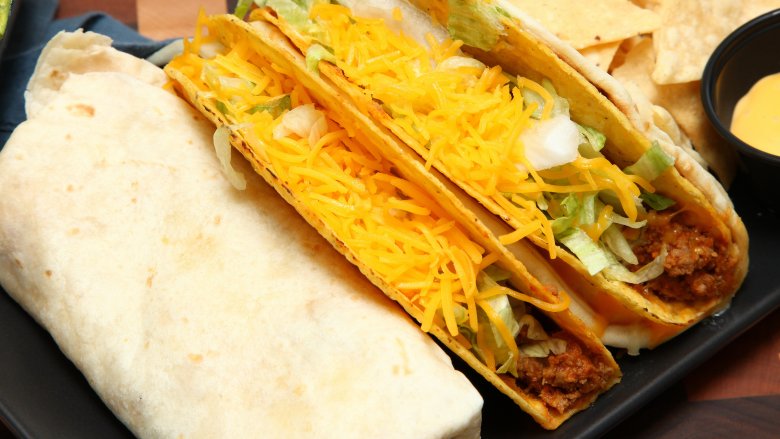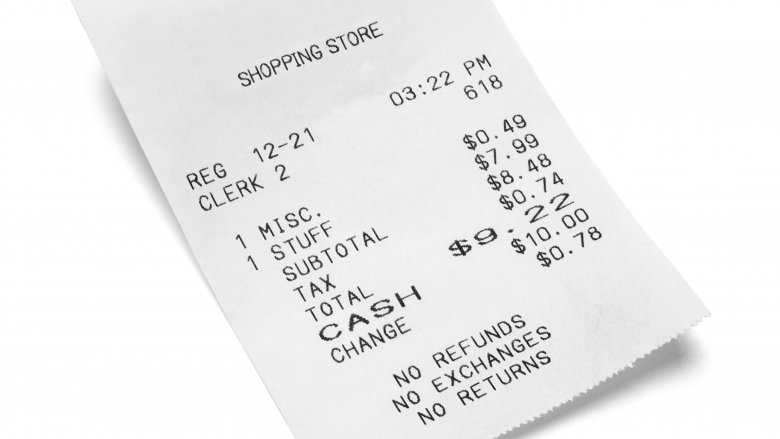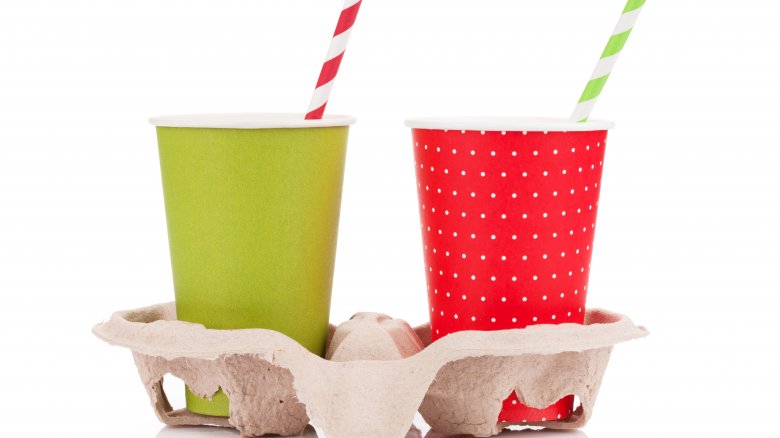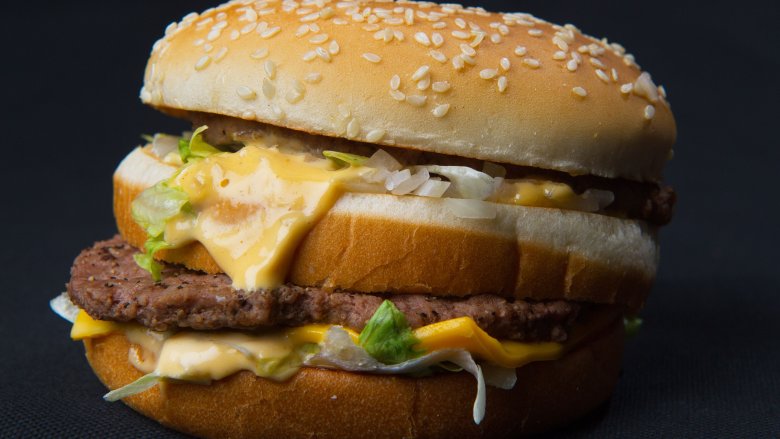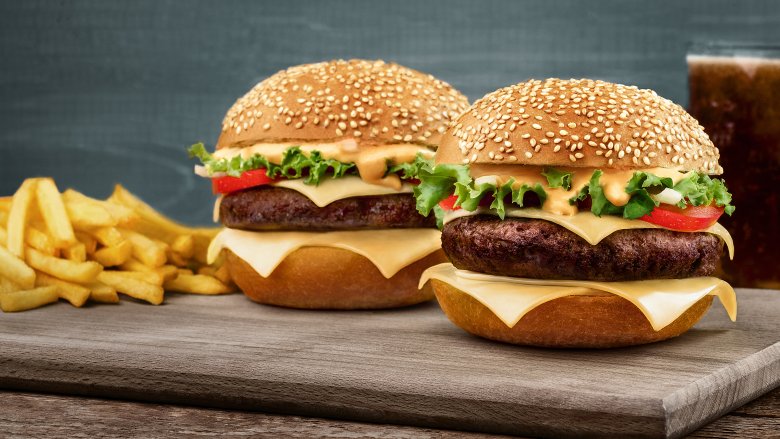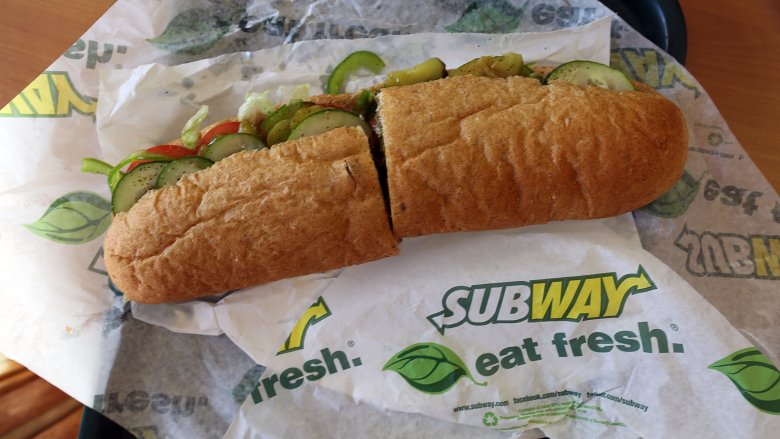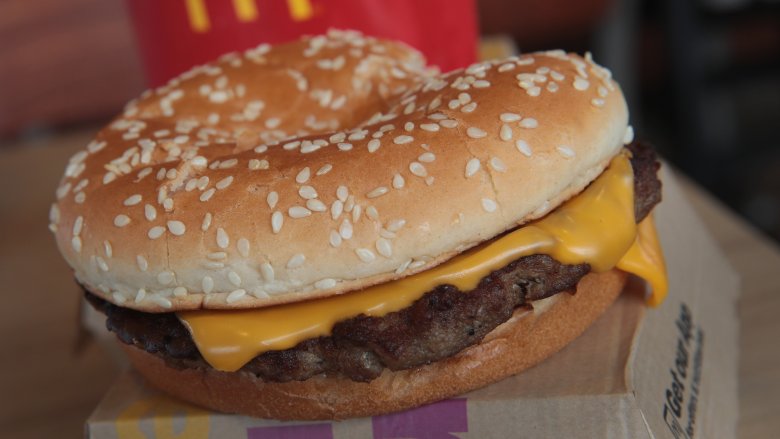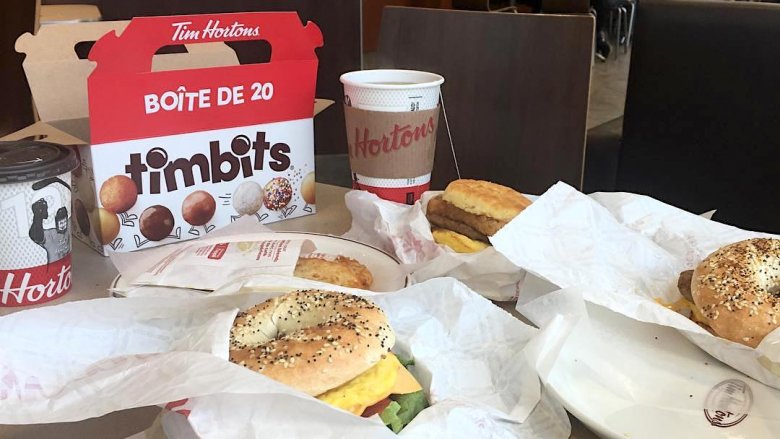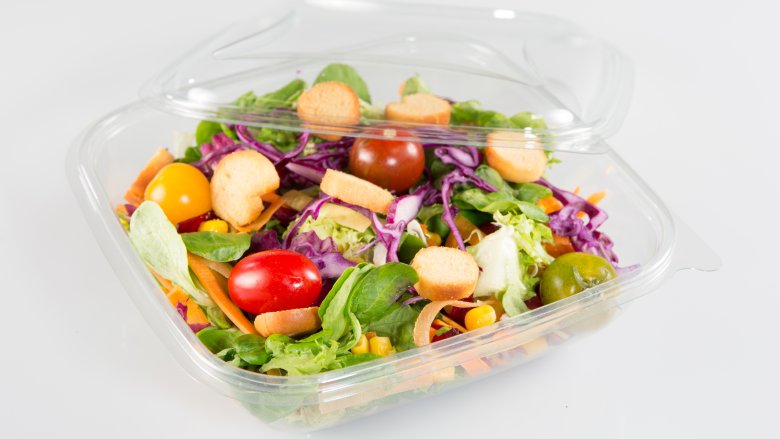Sneaky Ways Fast Food Restaurants Are Scamming You
In this day and age, we're always on the lookout for scams. Our inboxes are filled with an endless stream of phony emails requesting banking information and passwords. Our telephones ring off the hook with calls from would-be con artists pretending to be the IRS. Even knocks at the front door prompt a chain of warnings across neighborhood social networks. It can feel like everywhere you turn someone is trying to swindle you.
But it can't be all bad — there's got to be some rest for the weary, say when you walk into your neighborhood burger joint. You can let your guard down knowing they're going to take good care of you, right? Sorry, but nope. Unfortunately, fast food restaurants are not the safe haven you might be hoping for — they've been known to take advantage of their customers, too. Whether it's shady business practices or misleading advertising, here are all the ways your favorite eateries might be scamming you.
The french fry carton trick
If you've ever felt like you polished off that order of McDonald's french fries in embarrassingly short order, your voracious appetite might not be to blame. Thanks to a Reddit thread titled "What did your job want you to hide from customers?" we now know that under-filled cartons could be the culprit. One former Golden Arches employee alleged, "I worked at McDonald's and they taught me how to pinch the fry carton just right while putting the fries into them so that it looked full, but actually wasn't. I only had 1 customer call me out on it. He shook the fries out into his bag and poured them back into the fry carton himself and it only filled up half way, so I had to give him more fries. I was impressed and embarrassed." Another commenter chimed in, confirming, "I f**king hated that practice and basically refused to do it. Never got fired, but managed to have a few customers ask me when my shifts were the next week so they could have me filling their fries."
McDonald's denied any knowledge of this practice, saying, "We believe these claims to be fictional, there are no 'secret tricks' and we have strict operational procedures in place to ensure that fry portions are not under-filled." It might be a good idea to keep an eye on those french fry cartons, just in case.
Container sizes can be misleading
Do you get the cup of soup or the bowl? Do you go for a child's shake or indulge in a regular? Bad news: The items might be the same size. Even worse news: One might cost more than the other. Thanks again to Reddit, we now know we should be paying more attention to container sizes.
"The cup of soup and bowl of soup were the exact same size," one Redditor warned. "People would pay more for a bowl, and just get a cup of soup in a bowl that was shorter and wider at the bottom than the cup." While the reference is vague, commenters maintained that Steak 'n Shake is guilty of this practice, claiming, "100% they do. I've poured water into one after eating and then poured it out into the other and they're the same."
Shakes, too. "Where I work the child's milkshake goes into the normal child's cup which is 12oz. The regular milkshake goes into a milkshake cup which looks bigger because of the shape and the dome lid but still only holds 12oz. However the child's milkshake is cheaper than the regular," another Redditor confessed. But what about potential lawsuits? "We never actually claim they are different sizes. The only place where we state the size is on the nutritional board and they are accurate on that. The sizes available when asking for one is 'kids,' 'regular' and 'large.' So technically the company isn't falsely advertising anywhere."
Your McRib is definitely not rib
If you love the McDonald's McRib, you're definitely not going to love this bit of behind-the-scenes truth. (Though really, you had to think something was off about this sandwich, didn't you?)
Think about the shape of the iconic McRib patty... it looks like rib meat, right? Ribs and bones, to be exact. Well, obviously there aren't bones, since you can munch your way through the whole sandwich. So what's up with the shape? One Reddit user gave us a peek behind the curtain, and it's definitely weird. Turns out, the patties arrive to your local McDonald's flash frozen, pink, and in the same rib shape you're familiar with. That's not terribly surprising, but what is surprising is that without that browned look, and sans sauce, it looks nothing like ribs — and definitely not like something you'd want to eat.
McDonald's finally coughed up an ingredient list for the McRib in 2014 (spoiler: it's ground pork), so we know it's not rib meat we're actually eating. Still, with the shape of the patty, the saucy glaze, and of course, the name McRib, and it all adds up to a shady trick to make you think you're eating something you're not.
The Domino's Tracker might be a total sham
Ordering pizza for delivery has never been easier, thanks to the internet. You don't even have to talk to a real person! But one downside to all this technology is that systems can be manipulated, and not in the customer's favor.
Take the Domino's Tracker. This webpage allows you to see the exact status of your order — the problem is that it can be a bit misleading, according to one Redditor. "Domino's pizza tracker isn't accurate. Employees can enter s**t on the computer to make your order to appear at a different stage than it actually is... Apparently some stores show where the driver is, those are to my knowledge pretty accurate. The thing the employees change is the step in the series of steps to make and deliver your pizza. For example, the manager doesn't like the orders sitting on the shelf. The tracker says its passing quality inspection (sitting on a heated rack). So he will dispatch the order before a driver is there to take it. It makes the stores out the door time more impressive for the OERs [Operations Evaluation Report]."
Now if you've been waiting for a pizza that supposedly left the store an hour ago, you know why.
You might not be getting what you order
Fast food slogans like "Have it your way" and "We don't make it until you order it" have led us to believe that we'll get exactly what we order every time. Unfortunately, we know that this isn't always the case — everyone's had to send back a cheese-less cheeseburger at one time or another.
But what if you can't see any difference? You're going on blind faith that your order is correct, and according to these former fast food employees it might not be. One Redditor spilled a dirty coffee secret, saying, "The decaf at Burger King isn't actually decaf. It's just the regular coffee, but watered down." While some said they could relate to similar practices, others argued that this didn't apply to the company as a whole. The poster elaborated, "I'm just relating what I experienced when I worked at a Burger King. At mine, I was specifically instructed to water down the regular coffee. They had me do half and half."
If you have a strong preference for full-fat mayo, maybe think twice about noshing at Subway. Another Redditor confessed, "Former Subway employee. We put light mayonnaise in both bottles because it's cheaper than normal mayonnaise."
While these particular swaps might not be a big deal to everyone, you have to wonder how often this happens with other ingredients.
Your delivery order might be smaller than you expected
Would it ever occur to you to count the pieces of food in your delivery order? According to this former Domino's employee, there's a good reason to start doing just that. "Was a delivery driver for Domino's. I never did this personally because, well I just didn't lol but a few of the drivers ate the customers food in transit," they explained on Reddit. "[The drivers] wouldn't take a slice of pizza obviously because that would be noticed. But did you order 16 wings? You may end up with 14. 32 parmesan bread bites? Count again, there are 27. They'd also pick toppings off the pizza."
Unfortunately, unless you're willing to wait for a whole new order to be delivered, you're probably just going to settle for fewer wings and bread bites — but at least next time you'll know to tip accordingly if you get the same driver.
Grill marks mean nothing
Have you ever stopped to think about the fact that we can see grill marks on our food, and we can taste a distinct grilled flavor, yet there is not a grill to be found in most fast food kitchens? How in the world are they getting grill marks from a flat cooking surface? Spoiler: They're not.
Most fast food restaurants receive product from companies whose job it is to add those grill marks, and while they're at it they also add flavor enhancers to make it taste like it came straight off the barbecue. According to Food Republic, the deceptive burger patties and chicken pieces are soaked in a solution that includes salt, animal fats, smoke flavoring, and other preservatives before being cooked with blasts of hot air (nope, still no actual grilling happening here). After that, it's the pièce de résistance — the not-grilled food is branded to make it appear grilled.
You have to wonder: Wouldn't it be easier to just actually grill the darn things?
The beef might not be as beefy as you think
Everyone remembers the McDonald's pink slime scandal — you know, delicious burgers made out of beef trimmings treated with ammonia? Mmm. Since then, fast food companies have tried to put their best foot forward when it comes to transparency and quality of ingredients. McDonald's even invited a former Mythbuster into their facility to witness the patty-making process, and have assured all their customers that their beef is now free of pink slime. According to their website "every patty is 100% real beef with no fillers, additives or preservatives."
Not all companies have followed suit, though. Taco Bell admitted that their seasoned meat contained just 88 percent beef after a lawsuit alleged it contained only 35 percent. The company did disclose exactly what the remaining 12 percent is made up of — fillers, seasonings, emulsifiers, and thickeners — but aside from the clarification of ingredients in their seasoned beef, there came no promise to improve or make changes. In fact, according to NPR, Taco Bell actually released a statement saying it would not be making any changes to its products. So it's really up to you, now that you're informed — but is 12 percent non-beef really worth never having a Chalupa again?
Receipts that don't add up
Even with today's advanced technology, computers don't always get it right. And as several Panera customers learned, it can pay to be diligent about checking your meal receipts.
In 2017, Curtis Marquardt Jr., a Panera regular, told Chicago's WGN9 that he noticed an inflated total on a visit. "We go to Panera quite regularly and usually the total comes to about $30-$35," he said. "This one was over $40. [I thought] they must have raised their prices." But a price increase wasn't to blame — a computer glitch was. "There was an additional $9 in the subtotal but there was no item in the line items above that suggested it should add up to that amount. It was just an invisible $9 charge," Marquardt said.
In a statement to CountryLiving, the company said, "Panera takes the report of inaccurate receipts extremely seriously. As soon as we were made aware of this issue we began working to identify the cause. We found a rare glitch in the system which resulted in the charge... we implemented a change on our receipt structure which we believe has resolved this issue." However, others came forward with similar claims after hearing Marquardt's story, so this glitch may not have been so rare after all. Bottom line? Always check the bottom line on your receipts.
"Medium" is deceiving
Would you ever guess that the size of your soda cup could trick you into ordering more food? It can, and it does. Leave it to the fast food companies to figure out how to squeeze a few more dollars out of you.
Dr. Lisa Young, an internationally recognized nutritionist, wrote in Huffington Post that customers who order a medium soda will often give themselves a pat on the back for not ordering the large (make that obscenely large) soda, and then reward themselves with an extra food item, like French fries. But here's the thing: That medium soda that you're so proud of yourself for ordering is probably a whopping 20 to 30 ounces, which is at least twice as big as medium sodas once were. So not only are you drinking way more soda than you probably realized, you're also eating (and paying for) another item. Doesn't sound like such a win now, does it?
Speciality sandwiches can be a rip-off
When did Big Macs and Ultimate Cheeseburgers and Bacon Kings get so expensive? A trip through the drive-thru isn't quite the bargain it used to be, but some frugal Redditors have proven you can chow down on that specialty burger (or something very close) without feeling like you've been scammed out of cash — you just have to know how to order. Whether or not these following tricks work will depend on your local menu prices, but you'll get the idea. Think like these geniuses if you really want a deal:
- "Why buy a Big Mac when you can buy a McDouble for a dollar, hold the ketchup and mustard, and pay an extra quarter for Big Mac sauce? Get two of them for about $3, still under the cost of one Big Mac and way more food."
- "Same thing with Jack in the Box. Instead of ordering the double bacon cheeseburger for like $4, get 2 of the $1 Jr Bacon Cheese burgers. Take off one of the buns and stick them together. You are rewarded with $2 savings and an extra bun."
- "Wendy's has a Jr. cheeseburger for $1 but a double stack is $2.10. So I buy two Jr. cheeseburgers and make my own double stack. Cheaper plus you get two pieces of cheese instead of one."
- "Same thing at BK, they charge a $1 to add a patty to a single cheeseburger (to turn the 5 for 4 into a double bacon cheese). Instead I get a whole second burger and add it myself because you get an extra piece of cheese/lettuce/tomato."
What you see isn't always what you get
It can be hard to resist the temptation of fast food when we're constantly inundated with advertisements featuring perfectly made burgers. You know the ones — gooey melted cheese, the ripest tomato, the crispiest bacon. But the letdown is immediate when what you get in real life looks nothing like the picture promised, and unfortunately, that's probably never going to change.
Consumer Reports checked out seven fast food restaurants (including Subway, who was subsequently crowned "worst offender") to see how the pictures on the menus compared to what they actually ordered. For the most part they were — unsurprisingly — disappointed in the results. So if this is a universally recognized problem, why can't we expect a change? Isn't it false advertising?
Elizabeth Lordan, a press spokeswoman for the Federal Trade Commission, told CR that "truth-in-advertising laws do apply when restaurants show menu items in print and television ads... But the FTC hasn't pursued any cases alleging that food ads are deceptive based on photos," she said "That isn't surprising. The commission is unlikely to take law-enforcement actions in cases where consumers can easily evaluate the product, it's inexpensive, and it's frequently purchased." Sounds like we're all better off adjusting our expectations.
The food might be past its expiration date
There are two kinds of people in the world: Those who drink the milk after the "best by" date, and those who throw it away on that day even if the milk still smells just fine. If you fall into the latter group, the practice described by this former Subway employee on Reddit will make you cringe.
"I used to work at Subway. My manager at the time was really conscious of food costs... to a fault. Most commonly was changing the expiration dates of food so it wouldn't have to be thrown out," they explained. "This may not be a huge deal for a couple days, but food would last a couple WEEKS. He would also take lettuce in a pan and put it back into the bag. Finally, he kept frozen (unbaked) bread for over a year. It was so old that the yeast had died, causing the bread to not rise..."
Even if some of us are a little cavalier with the food in our own fridges, we would all like to assume that we're getting not expired food when we eat out. Not cool, Subway manager.
You might be paying for toppings you don't get
Once upon a time McDonald's had two Quarter Pounder options on their menu — one with cheese, and one without. The cheesy option justifiably cost more than the naked burger, as is the practice on most restaurant menus. But at some point, Mickey D's removed that cheeseless option, and your only recourse now is to order a Quarter Pounder without cheese, while still paying 30 – 90 cents for those fine slices of American that you don't actually get.
A lawsuit was brought against McDonald's over this very practice, claiming that "customers have been forced, and continue to be overcharged for these products, by being forced to pay for two slices of cheese, which they do not want, order, or receive, to be able to purchase their desired product."
The company blames this overcharge on their desire to satisfy customers — which seems a bit counter-intuitive — telling USA Today, "The advertised Quarter Pounder burger comes with cheese. We try to accommodate our customers' requests by allowing them to customize their orders, such as a Quarter Pounder with no cheese."
The obvious question is, why can't a bazillion dollar company take the 30 cent hit, instead of passing it onto the customer?
The food might not be as fresh as you think
As fast food joints are making a push to serve better food, we often see phrases like "freshly made" describing the fare. While we all know not to expect a farm to table experience when we hit the drive-thru, those words must account for something, right? Maybe not...
According to these former employees who spilled the tea on Reddit, a lot of that "made fresh" food is more like "frozen, then reheated" food.
"I worked at a Tim Hortons... The 'Always Fresh' stuff is kind of bull s**t. Everything is frozen, and re-heated when they need to be served," said one Redditor. "The doughnuts, the eggs in the breakfast sandwich, and any baked good was all frozen, put in the oven and then served."
Another dished, "Worked at Panera for four years. 1. All soups came in frozen and we just heated them up in plastic bags, this goes for the mac and cheese as well and many of the pastries, cookies, etc. 2. Our bakers only put things in the oven, the dough was mixed else where and shipped to the store. 3. Homestyle lemonade? Tap water and mix. Fresh Squeezed OJ? Poured from a carton to a cup. Iced Green Tea? Tap water and mix."
Of course, this doesn't necessarily mean the food is bad, but it can be a bit deceptive if you go in thinking you're getting a meal that's been prepared in-house that day.
The "healthy" menu items may be misleading
Fast food salads are made of lettuce, and since lettuce is good for us, salads are the best option at a fast food place, right? Wrong. These "healthy" menu items can be seriously misleading.
According to a 2009 study, it turns out — because brains are super weird, apparently — that the mere presence of these menu items can make you feel better about your fast food choices, even if those choices are ultimately a greasy burger, greasy fries, and a large chocolate shake. The phenomenon is called "vicarious goal fulfillment," and just seeing those leafy green options "satisfies your goal to eat healthy." Sounds like the perfect diet plan, doesn't it?
Another misconception is that these "healthier" options really are healthy, and — spoiler alert — they're not. How many times have we been warned that fast food salads can have more calories, fat, or sugar than a double bacon burger? Fordham University Assistant Professor Beth Vallen, one of the study's authors, explains, "It always drives the question of healthier versus healthy. [Burger King's] Satisfries, for example, are healthier than normal french fries. But they're not healthy."
